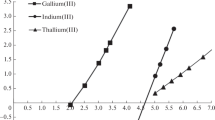Summary
The separation of uranium, lead, bismuth and thorium from a drop of solution containing uranyl acetate, lead nitrate, bismuth nitrate and thorium nitrate has been achieved, using the ring oven technique. The drop was taken on a circular filter paper, treated with1 N HNO3 and uranium was washed to the ring zone with n-butanol. Lead was next washed to the ring zone on another filter paper using 20% aqueous ethylenediamine hydrate. The spot was then treated with 1% aqueous sodium diethyldithioearbamate and bismuth was transported to the ring zone on a third paper with ethyl acetate. Finally 0.5N HNO3 was employed to transfer thorium to the ring zone. The separated rings were then compared with standard rings prepared similarly to compute the amounts of the ions present.
Zusammenfassung
Die Trennung von U, Pb, Bi und Th wurde mit dem Ringofen durchgeführt. Ein Tropfen der Lösung wird auf ein Rundfilter gebracht, mit n-HNO3 behandelt und das U mit n-Betanol in den Ring gewaschen. Blei wird auf einem anderen Filterpapier mit 20%iger wäßriger Äthylendiaminlösung in den Ring gewaschen, dann wird der Tüpfel mit 1%iger, wäßriger Lösung von Na-Diäthyldithiocarbamat behandelt und Wismuth auf einem 3-Filter mit Äthylacetat in den Ring gewaschen. Schließlich wäscht man Thorium mit 0,5-n Salpetersäure in den Ring. Die einzelnen Ringe werden mit Standardproben verglichen, um die Mengen abzuschätzen.
Résumé
On a réussi à séparer par la technique du four annulaire l'uranium, le plomb, le bismuth et le thorium dans une goutte de solution contenant de l'acétate d'uranyle, du nitrate de plomb, du nitrate de bismuth et du nitrate de thorium. La goutte est déposée sur un papier-filtre circulaire, traitée par HNO3 N et l'uranium est entraîné vers la zone annulaire par lavage avec du butanolN. Le plomb est ensuite entraîné vers la zone annulaire sur un autre papier filtre à l'aide d'éthylènediamine en solution aqueuse à 20%. La tache est alors traitée avec le diéthyldithiocarbamate de sodium en solution aqueuse à 1% et le bismuth transporté sur la zone annulaire sur un troisième papier par l'acétate d'éthyle. Finalement, on utilise HNO3 0,5N pour le transport comparé avec des anneaux types préparés de la même manière pour estimer les quantités d'ions présents.
Similar content being viewed by others
References
P. J. Antikainen, Suomenkem. B-31, 277 (1958).
E. Vassallo, Gazz. chim. ital.41, II, 204 (1912); Chem. Abstr.6, 49 (1912).
F. Feigl andH. A. Suter, Ind. Eng. Chem., Analyt. Ed.14, 840 (1942).
V. I. Kuznetsov, C. r. acad. Sci. (U. R. S. S.)31, 898 (1941); Chem. Abstr.37, 845 (1943).
V. I. Kuznetsov, J. Gen. Chem. (U. S. S. R.)14, 914 (1944); Chem. Abstr.39, 4561 (1945).
F. Feigl andR. Stern, Z. analyt. Chem.60, 39 (1921).
H. Weisz, Microanalysis by the Ring Oven Technique. New York: Pergamon. 1961.
Author information
Authors and Affiliations
Rights and permissions
About this article
Cite this article
Ghose, A.K., Chatterjee, R. & Dey, A.K. Separation, detection and determination of uranium, thorium, bismuth, and lead in a drop of solution by the ring oven technique. Mikrochim Acta 55, 685–689 (1967). https://doi.org/10.1007/BF01224389
Received:
Published:
Issue Date:
DOI: https://doi.org/10.1007/BF01224389



